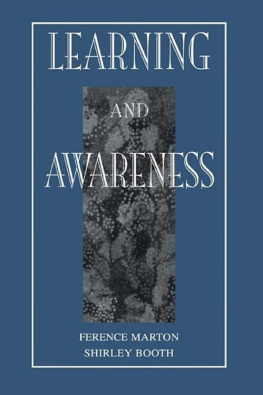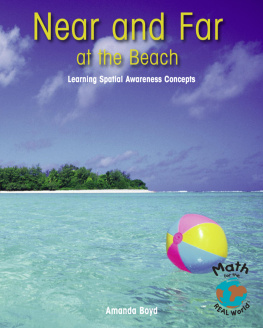Ference Marton - Learning and Awareness
Here you can read online Ference Marton - Learning and Awareness full text of the book (entire story) in english for free. Download pdf and epub, get meaning, cover and reviews about this ebook. year: 2013, publisher: Routledge, genre: Religion. Description of the work, (preface) as well as reviews are available. Best literature library LitArk.com created for fans of good reading and offers a wide selection of genres:
Romance novel
Science fiction
Adventure
Detective
Science
History
Home and family
Prose
Art
Politics
Computer
Non-fiction
Religion
Business
Children
Humor
Choose a favorite category and find really read worthwhile books. Enjoy immersion in the world of imagination, feel the emotions of the characters or learn something new for yourself, make an fascinating discovery.
- Book:Learning and Awareness
- Author:
- Publisher:Routledge
- Genre:
- Year:2013
- Rating:5 / 5
- Favourites:Add to favourites
- Your mark:
- 100
- 1
- 2
- 3
- 4
- 5
Learning and Awareness: summary, description and annotation
We offer to read an annotation, description, summary or preface (depends on what the author of the book "Learning and Awareness" wrote himself). If you haven't found the necessary information about the book — write in the comments, we will try to find it.
Learning and Awareness — read online for free the complete book (whole text) full work
Below is the text of the book, divided by pages. System saving the place of the last page read, allows you to conveniently read the book "Learning and Awareness" online for free, without having to search again every time where you left off. Put a bookmark, and you can go to the page where you finished reading at any time.
Font size:
Interval:
Bookmark:
Learning and Awareness

The Educational Psychology Series
Robert J, Sternberg, Series Editor
Marton/BoothLearning and Awareness
Learning and Awareness

Ference Marton
Gteborg University
Shirley Booth
Chalmers University of Technology

First Published by
Lawrence Erlbaum Associates, Inc., Publishers
10 Industrial Avenue
Mahwah, New Jersey 07430
Transferred to Digital Printing 2009 by Routledge
270 Madison Ave, New York NY 10016
2 Park Square, Milton Park, Abingdon, Oxon, OX14 4RN
Copyright 1997 by Lawrence Erlbaum Associates, Inc.
All rights reserved. No part of this book may be reproduced in any form, by photostat, microfilm, retrieval system, or any other means, without the prior written permission of the publisher.
Cover design by Kathryn Houghtaling
About the cover: The painting is Mukati Dreaming, by Dorothy Napangardi, partially reproduced here in black and white. It is owned by Birgitta Marton and was photographed for use on the cover by Otto Prohszka. Permission to use the art was granted on behalf of the artist by the Gallery Gondwana, Alice Springs.
Library of Congress Cataloging-in-Publication Data
Marton, Ference.
Learning and awareness/Ference Marton, Shirley Booth.
p. cm.
Includes bibliographical references and index.
ISBN 0-8058-2454-5 (cloth : alk. paper). ISBN 0-8058-2455-3 (pbk. : alk. paper)
1.Learning, Psychology of. 2. Awareness. Teaching. I. Booth, Shirley (Shirley A.) II. Title.
LB1060.M338 1997
370.1523dc20
96-46002
CIP
Publishers Note
The publisher has gone to great lengths to ensure the quality of this reprint but points out that some imperfections in the original may be apparent.
Contents
Prologue
Welcome. We hope that you are about to read the book that we, as we write these words, are on the point of completing. Maybe you are standing in a library, browsing in a book shop, sitting in front of the fire, or in your air-conditioned office. Wherever, you seem to have been moved to open the book, presumably curious as to what might be in it. Let us set the scene.
The book is about learning, not learning in all its shapes and forms, but learning in a particular senselearning as coming to experience the world, or aspects of the world, in particular ways. We give priority to the notion of experience, a notion that we develop successively throughout the book. The research that is described actually seeks the variation in ways in which people experience situations and phenomena in their worlds, generally studied with an educational research interest. Ways of experiencing things are described in terms of the structure of awareness, a word used synonymously with consciousness. But beware that in our research specialization, which we call phenomenography, awareness or consciousness does not carry the same connotations it does in certain other fields. These ideas are also developed in the course of the book.
In all modesty, it was never our aim to write a modest book. Indeed, we make a couple of claims that might be seen as bold. We claim, for instance, to have identified what for two millennia has been the major obstacle to man gaining important insights into the nature of learning of the kind we are interested in. In so doing, we claim to have arrived at a better understanding of learning, and hope that you will do so too.
Let us offer a taste of what is to come. Learningin the sense of gaining knowledge about the worldis frequently seen as a progression that starts with acquiring some basic facts (where facts are seen as pieces of valid, elementary knowledge) and goes on through building ever more complex and advanced forms of knowledge out of, or on the grounds of, simpler forms. Although learning does work like this in some cases, and can be forced to work like it in others, we do not believe it to be the prototypical path to learning. In our view, learning proceeds, as a rule, from an undifferentiated and poorly integrated understanding of the whole to an increased differentiation and integration of the whole and its parts. Thus, learning does not proceed as much from parts to wholes as from wholes to parts, and from wholes to wholes. To put it very simply, in order to learn about something you have to have some idea of what it is you are learning about.
The initial undifferentiated and unintegrated wholes that the learner grasps when embarking on learning something are likely to appear confused and erroneous when judged against the criteria of received wisdom. But on closer examinationand such closer examination will be going on throughout this bookthese wholes, the learners initial ideas, turn out to be partial rather than wrong. They are the seeds from which valid knowledge can grow. If we apply that message to the reading of this book, it means that all your previous experience of learning is the whole, and yet partial, and your readiness to look at it in an open way is your main resource when it comes to gaining insights into what we have to offer, provided that there are such insights to be found, of course.
We have tried to write this book in agreement with our view of what it takes to learn. We are not opening with a list of definitions of concepts that will be used later on, nor are we identifying all the facts, terms, and conditions of the work from the outset. We prefer to foreshadow concepts by introducing them first in a less than developed formoften through examplesand elaborating on them at appropriate points. We take up other traditions of research into learning (admittedly to a limited extent), not to provide a supporting framework for our arguments, but rather to highlight what differentiates our perspective from the alternatives and hence throw our arguments into relief.
The ideas that you meet in this book, you meet throughout this book. No one part can stand alone. In fact, we have developed our own ideas considerably in the course of writing this book, and we hope that the reader will do so too. Structure and meaning are interwoven; principles are related to examples, and these are used to bring out foundations and generalizations. There are progressions in the book that reflect our own way of understandingfrom the whole to the parts and back to the whole, from learning to teaching and back again to learning. There are threads to be followed, ideas that are be developed little by little, questions to be asked here, and answers to be sought there. By reading the whole bookmaybe focusing more on the things that interest you most, but all the time relating ideas to examples, being open to development of ideas that you already have met earlierwe hope that you will come to experience learning in the way that we do. In other words, we hope you will learn about learning.
In a peculiar way everything is everywhere in this presentation. Such a book is difficult to write, and we are afraid that it will be a bit difficult to read. But it is great fun to have written it, and we hope that it will be great fun to have read it.
So, again, welcome to the book. We leave it to you to judge the extent to which we have achieved our most sincere aim: to bring you to think differently about learningand to recognize it as a more enlightened and powerful waythan you do as you read these opening words.
Ference Marton
Shirley Booth
We have also been quite bold in our use of gender-specific words. Here man is used in its sense of all persons over time; elsewhere we have referred to individuals with male or female pronouns as we felt appropriate. We feel quite comfortable with this, because in Swedish the word for man is also the indefinite pronoun one, whereas the word for person (mnniska) takes the otherwise largely obsolete feminine pronoun. We hope that our readers are also comfortable with it.
Next pageFont size:
Interval:
Bookmark:
Similar books «Learning and Awareness»
Look at similar books to Learning and Awareness. We have selected literature similar in name and meaning in the hope of providing readers with more options to find new, interesting, not yet read works.
Discussion, reviews of the book Learning and Awareness and just readers' own opinions. Leave your comments, write what you think about the work, its meaning or the main characters. Specify what exactly you liked and what you didn't like, and why you think so.










